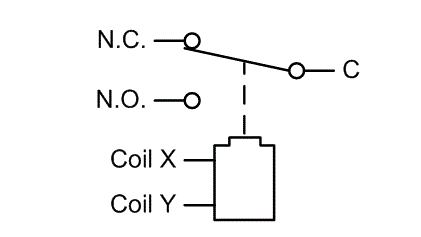Architecture
Conditional Logic
Semiconductors
Instruction Set
Serial Console
Example Programs
Build/Dev Log
Comments
RelaysRelays, one of the earliest electronic devices, invented by Joseph Henry in 1835, seem simple enough: energize an electro-magnet to pull an armature that closes a switch. De-energize the electro-magnet so that a spring returns the armature to its original position to open the switch. The switch can pass more current than is needed to energize the electro-magnet, so relays act as digital amplifiers. Basic relay terminologyThere is a naming scheme use to indicate the number of switches and terminals a relays contains. Poles refer to the number of switches controlled by a single electro-magnet. Throws refer to the number of contacts each switch has: single-throw (for a basic on-off switch) or double-throw (for an on-on switch with both "normally open" and "normally closed" contacts in addition to the common one). These combinations are all very common:

Figure 1 - Schematic symbol for SPDT Relay Relay connections:

Figure 2 Physical Diagram Advanced PropertiesAlthough seemingly simple device, their details are quite complex and relays have many "interesting" properties which are either useful to exploit or are pitfalls to be avoided. Pickup VoltageThe pickup voltage is the minimum voltage across the coil needed to close the switch. For example, for one particular "12V" relay, the pickup voltage is 7.5V. Dropout VoltageThe dropout voltage is the maximum voltage below which a closed switch will open. For example, for the same "12V" relay, the dropout voltage is 3.3 V. Why are pickup and dropout voltages so different (or different at all) you might ask? The equation for the force generated on the armature is: F = 2*pi*(N^2) / (A * (R0 + x/A)^2) Where:
The key point is that the force is stronger when the distance x is smaller (when the relay is closed), so lower "ampere-turns" (current) is needed to generate the same force. HeatThe resistance of the copper wire used in the coil increases with temperature, so the current through the relay will decrease if the voltage across the coil is held constant. The magnetic field strength is directly proportional to current, so the pickup and dropout voltages do vary with temperature. ContactsThe most troublesome part of a relay (or any switch) is the switch contacts. There is no ideal material for contacts: BounceThe switch contacts bounce when the relay is opened or closed, so you do not get a clean electrical edge. DirtIf particles of dirt get between the contacts, the switch will not be closed. Some relays are sealed and have bifurcated contacts (have two contacts in parallel) to help prevent this. Contact erosionThe contacts will erode over time due to mechanical wear and electrical arcing. Contact weldingAn arc may be strong enough to cause the contacts to weld together so that the relay "sticks" closed. Contact CarbonizingSoot from arcing can coat the contacts so badly that an electrical connection is not made when the relay is closed. Wetting CurrentIt turns out that having too low a current through the contacts also leads to reliability problems. A minimum "wetting current" is useful to clean oxide coatings off of the contacts. Oxide can build up on contacts to such a degree that a connection is not made even when the contacts are closed. Contact ForceWhen a relay is energized, there is a minimum amount of force needed beyond the minimum needed to just close the contacts. This increases the surface area of contacting region to provide a better connection. |